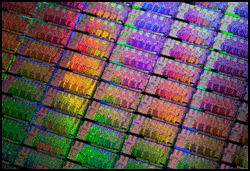Intel's second-generation Core processors feature some significant architecture changes, including putting both the computer and graphics processors on the same silicon die.
The new Sandy Bridge architecture behind the second-generation Core i7, i5, i3, and others should cut video transcoding times in half in many scenarios and help to meet consumer demand for much faster video processing and video and game streaming.

Fig. 1: Sandy Bridge Core processor wafer.
The new Sandy Bridge Core processors use Intel's 32nm logic process technology, incorporating high-k metal gate transistors and exceptional NMOS and PMOS transistor performance, and — to use Intel's words — “unifies processor cores, memory controller, last-level cache (LLC), and graphics and media processing” in a single solution. The combination of great process technology and more complete integration, enables measurable improvements in a number of areas of performance and efficiency.
Affecting Consumers
While improving device performance in general is almost always the goal for new processors, the Sandy Bridge update seems to directly address new consumer behaviors and demand.
For example, on average in 2010, desktop and laptop users posted about 20 million videos to Facebook per month, according to Royal Pingdom. Likewise, every minute of every day, about 24 hours of video is uploaded to YouTube.
Most of this user-generated video receives at least some basic editing and transcoding. Often these processes can take a lot of time even on relatively fast first-generation Core processors. With the Sandy Bridge architecture. most transcoding processes will take about half as long to complete, and some tasks might go even more quickly — Intel said that preparing a video that might take four minutes to transcode for an iPod, will take a Sandy Bridge processor about 16 seconds.
This topic hits very close to home for many users. As a specific example, the parents on the “Fans of Vallivue HS Wrestling,” Facebook page spend about 12 hours a week preparing their team videos for posting, if initial, published performance data for the second-generation Core processors is accurate, this video preparation time might drop to less than a hour thanks to the Sandy Bridge architecture's improvements.
Armando Roggio
Advertisement
Learn more about Electronic Products MagazineIntel





